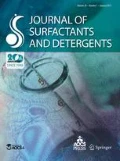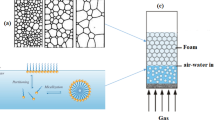Abstract
In spite of the increasing interest in cold temperature detergency of vegetable oils and fats, very limited research has been published on this topic. Extended surfactants have recently been shown to produce very promising detergency with vegetable oils at ambient temperature. However, the excessive salinity requirement (4–14 %) for these surfactants has limited their use in practical applications. In this work, we investigated the mixture of a linear C10–18PO–2EO–NaSO4 extended surfactant and a hydrophobic twin-tailed sodium dioctyl sulfosuccinate surfactant for cold temperature detergency of vegetable oils and semi-solid fats. Four vegetable oils of varying melting points (from −10 to 28 °C) were studied, these were canola, jojoba, coconut and palm kernel oils. Anionic surfactant mixtures showed synergism in detergency performance compared to single surfactant systems. At temperatures above the melting point, greater than 90 % detergency was achieved at 0.5 % NaCl. While detergency performance decreased at temperatures below the melting point, it was still superior to that of a commercial detergent (up to 80 vs. 40 %). Further, results show that the experimental microemulsion phase behaviors correlated very well with predictions from the hydrophilic–lipophilic deviation concept.






Similar content being viewed by others
References
The case for the “A.I.S.E. Low Temperature Washing” initiative. (2013) An initiative from the detergent industry to promote low temperature washing
Josephy B, Bush E, Nipkow J, Kleeli K, Glanzmann S (2013) Cold wash—Do prejudices impede high energy savings
Timms RE (1985) Physical properties of oils and mixtures of oils. J Am Oil Chem Soc 62(2):241–249. doi:10.1007/bf02541385
Phan T, Witthayapanyanon A, Harwell J, Sabatini D (2010) Microemulsion-based vegetable oil detergency using an extended surfactant. J Surfact Deterg 13(3):313–319. doi:10.1007/s11743-010-1184-9
Tongcumpou C, Acosta EJ, Quencer LB, Joseph AF, Scamehorn JF, Sabatini DA, Chavadej S, Yanumet N (2003) Microemulsion formation and detergency with oily soils: I. Phase behavior and interfacial tension. J Surfact Deterg 6(3):191–203. doi:10.1007/s11743-003-0262-5
Tanthakit P, Ratchatawetchakul P, Chavadej S, Scamehorn J, Sabatini D, Tongcumpou C (2010) Palm oil removal from fabric using microemulsion-based formulations. J Surfact Deterg 13(4):485–495. doi:10.1007/s11743-010-1219-2
Goel SK (1998) Measuring detergency of oily soils in the vicinity of phase inversion temperatures of commercial nonionic surfactants using an oil-soluble dye. J Surfact Deterg 1(2):221–226. doi:10.1007/s11743-998-0023-5
Raney K, Benson H (1990) The effect of polar soil components on the phase inversion temperature and optimum detergency conditions. J Am Oil Chem Soc 67(11):722–729. doi:10.1007/bf02540479
Lim J-C, Miller C (1991) Dynamic behavior in systems containing nonionic surfactants and polar oils and its relationship to detergency. In: Mittal KL, Shah DO (eds) Surfactants in solution. Springer, New York, pp 491–504
Miller CA (2006) Detergency for engineering applications of surfactant solutions. In: Somasunaran P, Hubbard AT (eds) Encyclopedia of surface and colloid science. Taylor & Francis, Boca Raton, pp 1664–1669
Thompson L (1994) The role of oil detachment mechanism in determining optimum detergency conditions. J Colloid Interface Sci 163:61–73
Komaki M, Kim S, Hashimoto T (2002) Fatty acid soil detergency performance of poly(sodium α-hydroxyacrylate). J Surfact Deterg 5(1):25–31. doi:10.1007/s11743-002-0201-5
Tanthakit P, Chavadej S, Scamehorn J, Sabatini D, Tongcumpou C (2008) Microemulsion formation and detergency with oily soil: IV. Effect of rinse cycle design. J Surfact Deterg 11(2):117–128. doi:10.1007/s11743-008-1062-x
Tongcumpou C, Acosta EJ, Quencer LB, Joseph AF, Scamehorn JF, Sabatini DA, Yanumet N, Chavadej S (2005) Microemulsion formation and detergency with oily soils: III. performance and mechanisms. J Surfact Deterg 8(2):147–156. doi:10.1007/s11743-005-340-8
Miller CA, Raney KH (1993) Solubilization-emulsification mechanisms of detergency. Colloids Surf A Physicochem Eng Asp 74(2–3):169–215
Miñana-Pérez M, Graciaa A, Lachaise J, Salager JL (1995) Solubilization of polar oils in microemulsion systems. In: Appell J, Porte G (eds) Trends in colloid and interface science IX. Progress in colloid and polymer science, vol 98. Steinkopff, pp 177–179
Salager J-L, Antón R, Sabatini D, Harwell J, Acosta E, Tolosa L (2005) Enhancing solubilization in microemulsions—state of the art and current trends. J Surfact Deterg 8(1):3–21. doi:10.1007/s11743-005-0328-4
Do L, Withayyapayanon A, Harwell J, Sabatini D (2009) Environmentally friendly vegetable oil microemulsions using extended surfactants and linkers. J Surfact Deterg 12(2):91–99. doi:10.1007/s11743-008-1096-0
Witthayapanyanon A, Phan T, Heitmann T, Harwell J, Sabatini D (2010) Interfacial properties of extended-surfactant-based microemulsions and related macroemulsions. J Surfact Deterg 13(2):127–134. doi:10.1007/s11743-009-1151-5
Phan T, Harwell J, Sabatini D (2010) Effects of triglyceride molecular structure on optimum formulation of surfactant-oil-water systems. J Surfact Deterg 13(2):189–194. doi:10.1007/s11743-009-1155-1
Pérez MM, Graciaa A, Lachaise J, Salager JL (1995) Solubilization of polar oils with extended surfactants. Colloids Surf A Physicochem Engr Asp 100:217–224
Salager JL, Forgiarini AM, Bullon J (2013) How to attain ultralow interfacial tension and three-phase behavior with surfactant formulations for enhanced oil recovery: a review. Part 1. Optimum formulation for simple surfactant-oil-water ternary systems. J Surfact Deterg 16:449–472
Salager JL, Forgiarini AM, Manchego L, Bullon J (2013) How to attain an ultralow interfacial tension and a three-phase behavior with a surfactant formulation for enhanced oil recovery: a review. Part 2. Performance improvement trends from Winsor's premise to currently proposed inter- and intra-molecular mixtures. J Surfact Deterg 16(5):631–663
Pérez MM, Graciaa A, Lachaise J, Salager JL (1996) Systems containing mixtures of extended-surfactants and conventional nonionics. In: Proceedings of 4th world surfactants congress, vol 2, pp 226–234
Smith GA, Hand KR (2006) Enhanced solubilization using extended chain surfactants. US Patent 2006/0211593
Garti N, Shevachman M, Shani A (2004) Solubilization of lycopene in jojoba oil microemulsion. J Amer Oil Chem Soc 81(9):873–877. doi:10.1007/s11746-004-0994-4
Acosta E, Kiran S, Hammond C (2012) The HLD-NAC model for extended surfactant microemulsions. J Surfact Deterg 15(4):495–504. doi:10.1007/s11743-012-1343-2
Kiran KK, Acosta EJ (2010) Predicting the Morphology and Viscosity of Microemulsions Using the HLD-NAC Model. Ind Eng Chem Res 49(7):3424–3432
Doan T, Acosta E, Scamehorn JF, Sabatini DA (2003) Formulating middle-phase microemulsions using mixed anionic and cationic surfactant systems. J Surfact Deterg 6(3):215–224. doi:10.1007/s11743-003-0264-3
Upadhyaya A, Acosta EJ, Scamehorn JF, Sabatini DA (2006) Microemulsion phase behavior of anionic-cationic surfactant mixtures: effect of tail branching. J Surfact Deterg 9(2):169–179. doi:10.1007/s11743-006-0387-6
Salager JL (1999) Ionic microemulsions. In: Broze G (ed) Handbook of detergents - Part A: Properties. Marcel Dekker, New York, pp 247–280
Salager JL (1996) Quantifying the concept of physico-chemical formulation in surfactant-oil-water systems—state of the art. In: Solans C, Infante MR, García-Celma MJ (eds) Trends in colloid and interface science X. Progress in colloid polymer science, vol 100. Steinkopff, pp 137–142
Salager JL, Morgan JC, Schchter RS, Wade WH (1979) Optimum formulation of surfactant/water/oil systems for minimum interfacial tension or phase behavior. SPE J 19:107–109
Acosta E, Yuan J, Bhakta A (2008) The characteristic curvature of ionic surfactants. J Surfact Deterg 11(2):145–158. doi:10.1007/s11743-008-1065-7
Acosta EJ, Szekeres E, Sabatini DA, Harwell JH (2003) Net-average curvature model for solubilization and supersolubilization in surfactant microemulsions. Langmuir 19:186–195
Salager JL, Marquez N, Graciaa A, Lachaise J (2000) Partitioning of ethoxylated octylphenol surfactants in microemulsion-oil water systems: influence of temperature and relation between partitioning coefficient and physicochemical formulation. Langmuir 16:5534–5539
Antón R, Andérez J, Bracho C, Vejar F, Salager J-L (2008) Practical surfactant mixing rules based on the attainment of microemulsion–oil–water three-phase behavior systems. In: Narayanan R (ed) Interfacial processes and molecular aggregation of surfactants. Advances in Polymer Science, vol 218. Springer, Berlin, Heidelberg, pp 83–113
Witthayapanyanon A, Harwell JH, Sabatini DA (2008) Hydrophilic–lipophilic deviation (HLD) method for characterizing conventional and extended surfactants. J Colloid Interface Sci 325(1):259–266. doi:10.1016/j.jcis.2008.05.061
D4265-98 ASTMA (2000) Standard guide for evaluating stain removal performance in home laundering. Annual book of ASTM standards, vol 15.04, West Conshohocken
Jadidi N, Adib B, Malihi FB (2013) Synergism and performance optimization in liquid detergents containing binary mixtures of anionic-nonionic, and anionic-cationic surfactants. J Surfact Deterg 16(1):115–121. doi:10.1007/s11743-012-1371-y
Salager JL, Manchego L, Márquez L, Bullón J, Forgiarini A (2014) Trends to attain a lower interfacial tension in a revisited pure alkyl polyethylene glycol surfactant–alkane–water ternary system. Basic concepts and straightforward guidelines for improving performance in enhanced oil recovery formulations. J Surfact Deterg 17(2):199–213. doi:10.1007/s11743-013-1534-5
Velásquez J, Scorzza C, Vejar F, Forgiarini A, Antón R, Salager J-L (2010) Effect of temperature and other variables on the optimum formulation of anionic extended surfactant–alkane–brine systems. J Surfact Deterg 13(1):69-73. doi:10.1007/s11743-009-1142-6
Shinoda K, Kunieda H (1982) Phase behavior in systems of nonionic-surfactant/water/oil around the hydrophile-lipophile-balance-temperature (HLB-temperature). J Dispersion Sci Technol 3:233–244
Kahlweit M, Strey R (1988) Phase behavior of quinary mixtures of the type H2O-oil-nonionic amphiphile-ionic amphiphile-salt. J Phys Chem 92:1557–1563
Acknowledgments
The authors would like to thank George Smith from Huntsman Corporation (The Woodlands, TX) for providing the extended surfactant sample. Funding for this work was provided by industrial sponsors of the Institute for Applied Surfactant Research at the University of Oklahoma: CESI Chemical, Church & Dwight, Clorox, Conoco Phillips, Ecolab, GlaxoSmithKline, Haliburton Services, Huntsman, InVia Westvaco, Novus, Procter and Gamble, Phillips 66, Sasol, SC Johnson and Shell Chemicals.
Author information
Authors and Affiliations
Corresponding author
About this article
Cite this article
Do, L.D., Attaphong, C., Scamehorn, J.F. et al. Detergency of Vegetable Oils and Semi-Solid Fats Using Microemulsion Mixtures of Anionic Extended Surfactants: The HLD Concept and Cold Water Applications. J Surfact Deterg 18, 373–382 (2015). https://doi.org/10.1007/s11743-014-1659-1
Received:
Accepted:
Published:
Issue Date:
DOI: https://doi.org/10.1007/s11743-014-1659-1




